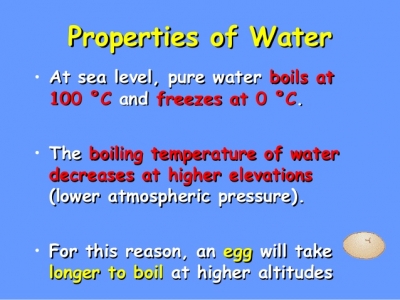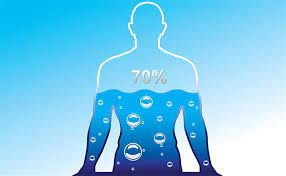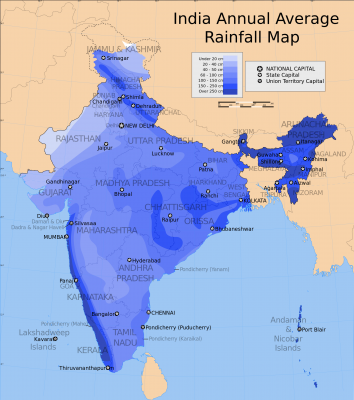
Almost all plants and animals need air, water, light, and nutrition to grow. Green plants use a complicated chemical process, called photosynthesis, to create energy for survival and growth. Since plants create their own energy, they are the first link in the food chain. Animals need to drink water and eat plants or other animals to get energy. Therefore, they are present at the next step in the food chain. There are some animals, like camels, that can survive for days without drinking water. Since they live in deserts with very little water, they have adapted to the special conditions of their habitat.
 The chloroplast inside the green leaves of plants is the ‘workshop’ where photosynthesis takes place. Water is supplied to the leaves by the roots, and carbon dioxide is absorbed from the air through tiny pores on the lower side of the leaf. Both these are broken down into the elements hydrogen (H), carbon (C), and oxygen (O) with the help of chlorophyll and sunlight. Plants build ‘glucose’ (grape sugar) from these elements and oxygen is released in the atmosphere as a by-product. Photosynthesis has been the source of oxygen in the air since the origin of life on the Earth.
The chloroplast inside the green leaves of plants is the ‘workshop’ where photosynthesis takes place. Water is supplied to the leaves by the roots, and carbon dioxide is absorbed from the air through tiny pores on the lower side of the leaf. Both these are broken down into the elements hydrogen (H), carbon (C), and oxygen (O) with the help of chlorophyll and sunlight. Plants build ‘glucose’ (grape sugar) from these elements and oxygen is released in the atmosphere as a by-product. Photosynthesis has been the source of oxygen in the air since the origin of life on the Earth.
 Unlike animals, plants produce their own food and except for a few carnivorous plants, do not eat other organisms. Green plants use water, nutrients, and a green matter in their leaves called ‘chlorophyll’ to produce their food. Normally water and nutrients are absorbed from the ground through their roots. Some plants, however, have developed other methods for obtaining water and nutrients. Many tree-dwelling plants make funnel-shaped ‘containers’ with their leaves to catch water. Carnivorous plants use their digestive juices to convert the insects, caught in their folding or sticky traps, into nutrients.
Unlike animals, plants produce their own food and except for a few carnivorous plants, do not eat other organisms. Green plants use water, nutrients, and a green matter in their leaves called ‘chlorophyll’ to produce their food. Normally water and nutrients are absorbed from the ground through their roots. Some plants, however, have developed other methods for obtaining water and nutrients. Many tree-dwelling plants make funnel-shaped ‘containers’ with their leaves to catch water. Carnivorous plants use their digestive juices to convert the insects, caught in their folding or sticky traps, into nutrients.
 Almost all plants and animals need air, water, light, and nutrition to grow. Green plants use a complicated chemical process, called photosynthesis, to create energy for survival and growth. Since plants create their own energy, they are the first link in the food chain. Animals need to drink water and eat plants or other animals to get energy. Therefore, they are present at the next step in the food chain. There are some animals, like camels, that can survive for days without drinking water. Since they live in deserts with very little water, they have adapted to the special conditions of their habitat.
Almost all plants and animals need air, water, light, and nutrition to grow. Green plants use a complicated chemical process, called photosynthesis, to create energy for survival and growth. Since plants create their own energy, they are the first link in the food chain. Animals need to drink water and eat plants or other animals to get energy. Therefore, they are present at the next step in the food chain. There are some animals, like camels, that can survive for days without drinking water. Since they live in deserts with very little water, they have adapted to the special conditions of their habitat.
 Below a certain depth all the porous spaces are saturated with water. This upper limit of the ground water is called the water table.
Below a certain depth all the porous spaces are saturated with water. This upper limit of the ground water is called the water table.
 Water cycle or hydrological cycle is the natural evaluations of water through biosphere. Water is lost from earth’s surface to the atmosphere by evaporation from rivers, oceans, and seas etc. This atmospheric water forms clouds and creates rainfall. The water that collects on land, again flows to oceans, seas and rivers etc., and completes the cycle.
Water cycle or hydrological cycle is the natural evaluations of water through biosphere. Water is lost from earth’s surface to the atmosphere by evaporation from rivers, oceans, and seas etc. This atmospheric water forms clouds and creates rainfall. The water that collects on land, again flows to oceans, seas and rivers etc., and completes the cycle.


 Rain, snow, rivers, streams, brooks, lakes, ponds, wells, springs, underground water, ice sheets, etc. are the main sources of water.
Rain, snow, rivers, streams, brooks, lakes, ponds, wells, springs, underground water, ice sheets, etc. are the main sources of water.
 Pure water is colourless, odourless and tasteless. It can exist as solid (ice), liquid (water) and gas (steam). Water freezes at 0°C or 32° F and boils at 100°C or 212°F. It is a peculiar liquid in that it expands when it freezes. That is why ice floats on water.
Pure water is colourless, odourless and tasteless. It can exist as solid (ice), liquid (water) and gas (steam). Water freezes at 0°C or 32° F and boils at 100°C or 212°F. It is a peculiar liquid in that it expands when it freezes. That is why ice floats on water.
 Water makes up 60-70% of the human body or about 40 liters of which 25 are inside the cells, 15 outside. People can't survive normally more than five or six days without water or two or three days in a hot environment.
Water makes up 60-70% of the human body or about 40 liters of which 25 are inside the cells, 15 outside. People can't survive normally more than five or six days without water or two or three days in a hot environment.

 To scientists, water is a compound of hydrogen and oxygen. One molecule of water contains two atoms of hydrogen and one atom of oxygen. There is about 1.4 billion Cubic kilometer of water on the earth which covers about 71% of the earth's surface. About 97% of the water on the earth is in the oceans.
To scientists, water is a compound of hydrogen and oxygen. One molecule of water contains two atoms of hydrogen and one atom of oxygen. There is about 1.4 billion Cubic kilometer of water on the earth which covers about 71% of the earth's surface. About 97% of the water on the earth is in the oceans. 

 Nuclear fusion is the process whereby two atomic nuclei are fused with the release of a large amount of energy. Very high temperatures and pressures are thought to be required in order for the process to happen. The process might one day be harnessed to form the basis of commercial energy. Method of achieving controlled fusion is the subject of research around the world.
Nuclear fusion is the process whereby two atomic nuclei are fused with the release of a large amount of energy. Very high temperatures and pressures are thought to be required in order for the process to happen. The process might one day be harnessed to form the basis of commercial energy. Method of achieving controlled fusion is the subject of research around the world.


 The world’s largest solar plant is located in the MOJAVE desert neat Dagget, California. It currently producing 675 MW of electricity, enough energy for one million people.
The world’s largest solar plant is located in the MOJAVE desert neat Dagget, California. It currently producing 675 MW of electricity, enough energy for one million people.
 Solar energy absorbed by the earth is equivalent to 3000 times the heat in all the coal and petroleum produced in the world in a year.
Solar energy absorbed by the earth is equivalent to 3000 times the heat in all the coal and petroleum produced in the world in a year.